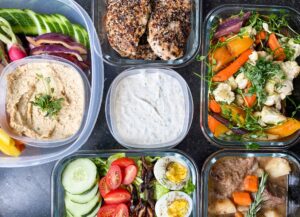Meal Prep Like a Pro Your Guide to Healthy Time-Saving Meals
Meal prepping is a game-changer for anyone looking to save time, eat healthier, and reduce the daily stress of figuring out what’s for lunch or dinner. By dedicating a few hours each week to planning and preparing meals, you can set yourself up for success, whether you’re aiming to stick to a budget, hit your fitness goals, or simply streamline your week. This comprehensive guide will walk you through the art and science of meal prepping like a pro, covering everything from planning and shopping to storage and reheating. With practical tips, sample recipes, and strategies to keep things exciting, you’ll be ready to transform your kitchen routine.
Why Meal Prep?
Meal prepping isn’t just about cooking in bulk—it’s about taking control of your diet and schedule. Here are some key benefits:
- Time Savings: Preparing meals in advance means less time spent cooking during the week, freeing you up for other priorities.
- Cost Efficiency: Buying ingredients in bulk and reducing food waste can significantly cut down on grocery bills.
- Healthier Choices: When meals are pre-planned, you’re less likely to reach for takeout or processed snacks.
- Portion Control: Prepping meals helps you manage portion sizes, which is especially useful for weight management or fitness goals.
- Reduced Stress: Knowing your meals are ready to go eliminates the daily “what’s for dinner?” dilemma.
Whether you’re a busy professional, a parent, or a student, meal prepping can simplify your life while keeping your nutrition on track.
Getting Started: The Basics of Meal Prepping
Meal prepping may seem daunting at first, but with a clear plan, it’s surprisingly straightforward. Here’s how to begin:
1. Plan Your Meals
Start by deciding how many meals you want to prep for the week. Most beginners focus on lunches and dinners for five days, but you can also include breakfasts or snacks. Consider your schedule—will you need portable meals for work or school? Are there days when you’ll eat out? Once you know how many meals you need, choose recipes that are simple, balanced, and suited to your dietary preferences.
A good rule of thumb is to build meals around the following components:
- Protein: Chicken, turkey, beef, fish, tofu, eggs, or legumes.
- Carbohydrates: Brown rice, quinoa, sweet potatoes, whole-grain pasta, or oats.
- Vegetables: Broccoli, spinach, zucchini, bell peppers, or carrots.
- Healthy Fats: Avocado, olive oil, nuts, or seeds.
Plan for variety to avoid boredom. For example, you might prep two different proteins (like chicken and salmon) and alternate them with different vegetables and grains throughout the week.
2. Make a Shopping List
Once your meals are planned, create a detailed shopping list. Group ingredients by category (produce, proteins, pantry staples) to make your grocery trip more efficient. Check your pantry first to avoid buying duplicates, and consider purchasing in bulk for non-perishable items like rice or canned beans to save money.
3. Choose the Right Tools
Investing in quality meal prep tools can make the process smoother. Essential items include:
- Containers: Glass or BPA-free plastic containers with tight-fitting lids are ideal for storing meals.
- Kitchen Equipment: A good knife, cutting board, baking sheets, and a slow cooker or Instant Pot can save time.
- Measuring Tools: Measuring cups and a kitchen scale help with portion control.
Meal Prep Strategies for Success
To meal prep like a pro, you’ll need strategies to maximize efficiency and keep your meals fresh and appetizing. Here are some expert tips:
Pro Tip: Batch Cooking
Cook large quantities of staple ingredients—like grilled chicken, roasted vegetables, or quinoa—at once. These can be mixed and matched to create different meals throughout the week.
Prep in Stages: Break the process into manageable steps. For example, chop vegetables and marinate proteins the night before your main cooking day. This spreads out the workload and makes the process less overwhelming.
Season Smartly: Use versatile seasonings to keep meals flavorful without requiring a dozen different spices. A simple mix of olive oil, garlic, salt, pepper, and paprika works for most proteins and vegetables.
Storage Matters: Store meals in airtight containers to maintain freshness. Divide meals into single portions for grab-and-go convenience, and label containers with the date to track freshness.
Reheat Properly: To avoid soggy or overcooked meals, reheat gently in a microwave (use a microwave-safe cover to trap steam) or on the stovetop. Add a splash of water or broth to keep dishes moist.
Sample Meal Prep Recipes
Here are two beginner-friendly meal prep recipes that are nutritious, flavorful, and easy to make in bulk.
Recipe 1: Chicken and Quinoa Power Bowl
Ingredients (Serves 4):
- 4 boneless, skinless chicken breasts
- 1 cup quinoa, rinsed
- 2 cups broccoli florets
- 1 red bell pepper, sliced
- 2 tbsp olive oil
- 1 tsp garlic powder
- 1 tsp paprika
- Salt and pepper to taste
- Optional: Lemon wedges for serving
Instructions:
- Preheat oven to 400°F (200°C). Toss broccoli and bell pepper with 1 tbsp olive oil, salt, and pepper. Spread on a baking sheet and roast for 20 minutes.
- Season chicken breasts with garlic powder, paprika, salt, and pepper. Heat 1 tbsp olive oil in a skillet over medium heat and cook chicken for 6-7 minutes per side until cooked through.
- Cook quinoa according to package instructions (typically 1 cup quinoa to 2 cups water, simmer for 15 minutes).
- Divide quinoa, roasted vegetables, and sliced chicken into four containers. Squeeze lemon juice over each portion before serving for extra flavor.
Storage: Refrigerate for up to 4 days. Reheat in the microwave for 2-3 minutes.
Recipe 2: Vegetarian Chickpea Curry
Ingredients (Serves 4):
- 2 cans (15 oz each) chickpeas, drained and rinsed
- 1 can (14 oz) coconut milk
- 1 cup diced tomatoes
- 1 onion, chopped
- 2 cups spinach
- 2 tbsp curry powder
- 1 tbsp olive oil
- Salt to taste
- 2 cups cooked brown rice
Instructions:
- Heat olive oil in a large pot over medium heat. Sauté onion until translucent, about 5 minutes.
- Add curry powder and stir for 1 minute. Add chickpeas, tomatoes, and coconut milk. Simmer for 15 minutes.
- Stir in spinach until wilted, about 2 minutes. Season with salt.
- Divide brown rice and curry into four containers.
Storage: Refrigerate for up to 5 days. Reheat in the microwave or on the stovetop with a splash of water.
Keeping Meal Prep Exciting
One of the biggest challenges of meal prepping is avoiding monotony. Here are some ways to keep your meals fresh and exciting:
- Switch Up Sauces: A simple change in sauce—think pesto, tahini, or sriracha—can transform the same ingredients into a new dish.
- Try New Cuisines: Experiment with flavors from different cultures, like Mexican, Thai, or Mediterranean, to keep things interesting.
- Seasonal Ingredients: Incorporate seasonal produce to add variety and freshness to your meals.
- Snack Prep: Prep healthy snacks like cut veggies, hummus, or energy balls to complement your meals and curb cravings.
Pro Tip: Theme Your Days
Assign themes to each day of the week, like “Meatless Monday” or “Taco Tuesday,” to add structure and excitement to your meal plan.
Common Meal Prep Mistakes to Avoid
Even seasoned meal preppers make mistakes. Here are some pitfalls to watch out for:
- Overcomplicating Recipes: Stick to simple recipes with minimal ingredients, especially when starting out.
- Ignoring Food Safety: Cool food completely before storing to prevent bacterial growth. Don’t leave perishable items out for more than 2 hours.
- Not Prepping Enough Variety: Eating the same meal every day can lead to burnout. Plan at least two different meals per week.
- Poor Portioning: Use a kitchen scale or measuring cups to ensure portions meet your nutritional needs.
Conclusion
Meal prepping is a powerful tool for saving time, eating healthier, and reducing stress. By planning your meals, investing in the right tools, and following smart strategies, you can master the art of meal prepping like a pro. Start small, experiment with recipes, and don’t be afraid to tweak your approach as you learn what works best for you. With a little practice, you’ll be enjoying delicious, home-cooked meals all week long—without the daily hassle.






